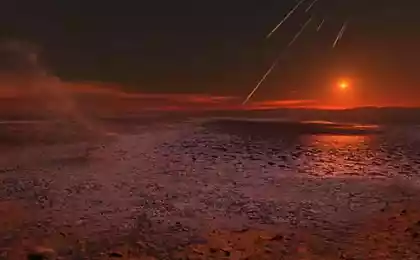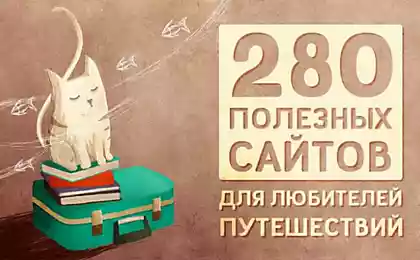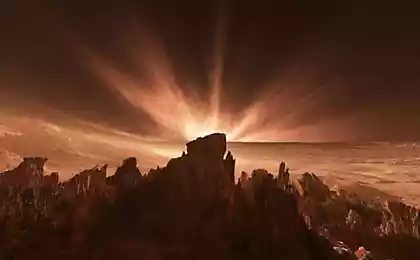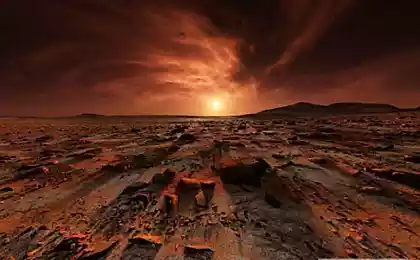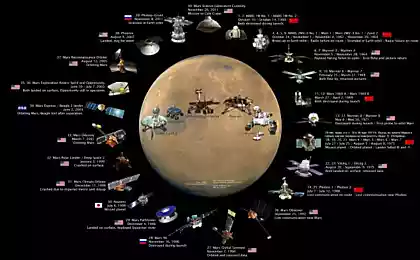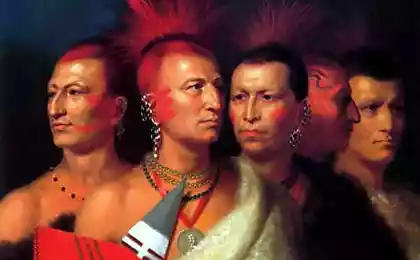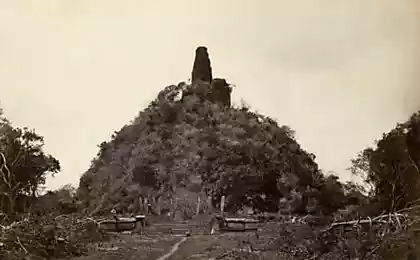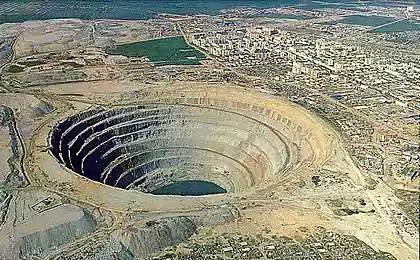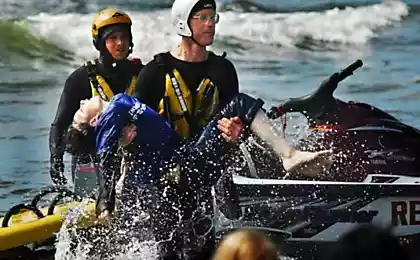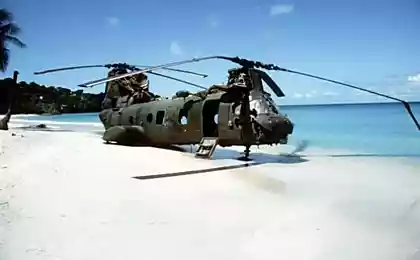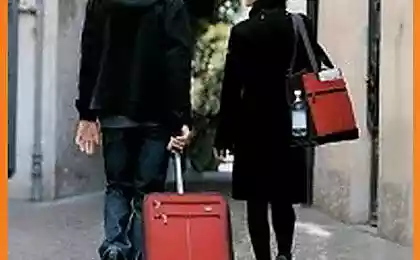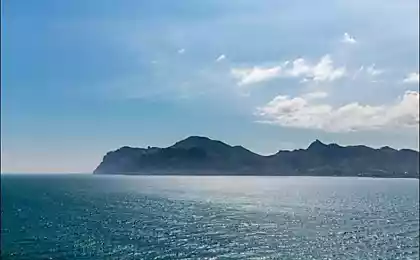1574
Wau en Namus extinct volcanic crater
Wau en Namus is an extinct volcanic crater, which is far away in the Sahara desert in Libya. His name Wau en Namus (translated as "crater Mosquito") he received from the fact that the surrounding small lakes full of mosquitoes. Wau en Namus - a dormant volcano surrounded by black sand.
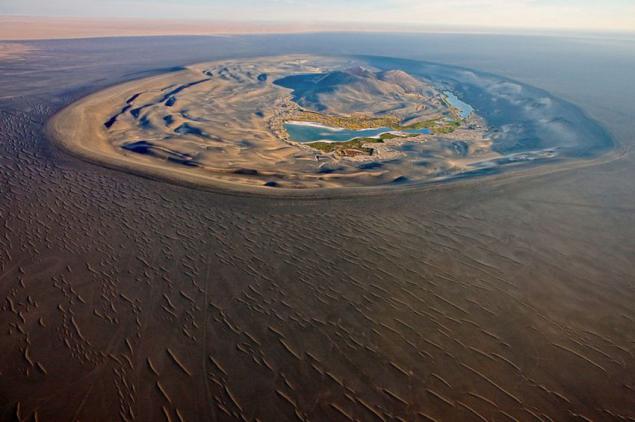
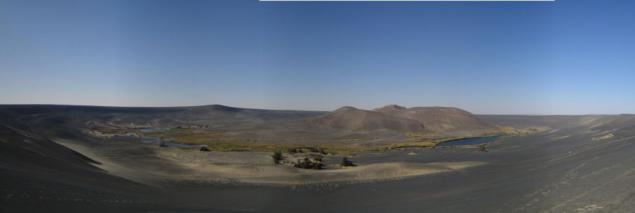
The general phenomenon in the Sahara desert - the emergence of drinking water close, or almost the same place where the salt lakes. This water source feeds the lake, and has even been used by travelers in the old days. Due to the presence of fresh water in this remote volcano Wau en Namus, has always been an important point for caravans en route from Waw Al Kabir to the oases and al Kufraha Rebiany in south-eastern Libya.

The size of the caldera Wau en Namus, and the adjacent fields are so large that they can be seen from Earth orbit.

On a picturesque volcano first reported by the outside world, Karl Moritz von Boyrman (1862) and Gerard Rohlfs (1881), although they have never visited this place. Probably the first European who visited the volcano and said about him, was a Frenchman, Laurent Lapierre (1920). Lapierre was an officer who had been captured in battle and escorted through these places. He has an opportunity to tell about his adventures after his release a few years later.

About eleven years later, the Italian geologist Ardito Desio reached Wau en Namus during his famous expedition on camels. In his geological expedition Desio also visited many other places and made a geological description of the volcano for the first time in 1935.
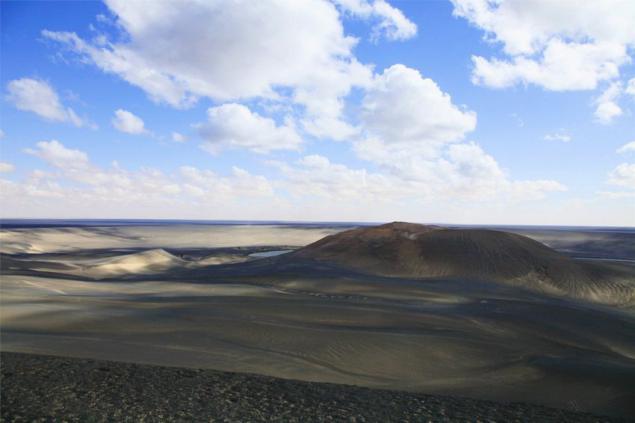
After the Second World War, several scientists visited the volcano, including a geographer Nicholas Benjamin Richter, who made several visits and published a book on his trip to the region in 1960. Since that time, and because the Libyan government began issuing oil concessions in Libya, several geologists, geophysicists and tourists visited Wau-Namus, to explore adjacent areas, or because they were involved in the descriptions of the volcano. Over the past two decades Namus has become one of the main destinations for most tourists who visit the Libyan desert in general, and the Fezzan region in particular.

The area near the caldera is of great interest not only for geologists but also for historians and archaeologists. In the region were found traces of the ancient culture of Nok, including very high-quality items made of iron.
Wau en Namus - a popular tourist attraction, every year it visited by hundreds of guests from all over the world.
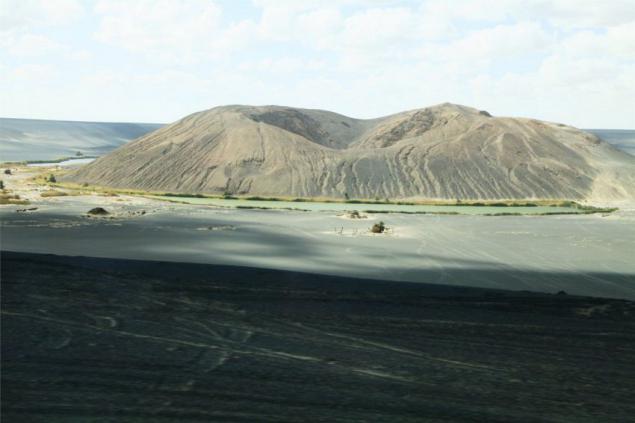
Tells traveler Borisov
Nicholas: And today I invited a hammam traveler Borisov, who has several times been in the Sahara. Alex, tell us about your impressions.
Alex: When I remember my trip to the Middle East and North Africa, the first thing comes to mind is the image of the desert. Indeed, most of the territory of the country is desert, including the greatest of them - the Sahara. About her I will tell.
"The Lost World" - not the one on which he wrote Conan Doyle, and existing in reality - is at the heart of the Sahara and is marked on the map of Libya Arabic script, emerging in the name of "Wow en Namus". The path to it, we started a thousand kilometers from the Mediterranean Sea in an oasis Temessa. Here ends the asphalt, hence we had to overcome 300 kilometers of emptiness - emptiness of the absolute, where there are no roads, no people, no animals or even plants. Can you imagine what are as yet unknown to you parts of our planet.
Ivan: And you're not kidding? It is possible today to get into the lost world? And it's so easy?
Alex: Of course not. Venture on such a journey we must prepare for what will have to face the real dangers that await the traveler in the desert. Of course, those times when caravans crossed the Sahara, slowly move from oasis to oasis and leave behind the dead camels and people are gone. Today's travelers are moving jeep, enjoying the coolness of the air conditioners. And yet ...
Anne: Journey to the modern machines, air-conditioned ... No dangerous you say?
Alex: The main danger of such trips - a shortage of gasoline. Too heavy sands lead to a waste of fuel. And if losing orientation, the machine skips past the oasis, gasoline is quickly coming to an end, for it ends with water, and with it the life.
Natasha: Are you talking seriously?
Alex: It is serious. Desert - is unknown. However, before going into the absolute emptiness, tourists are sure to report to the police, and if the tourists do not come back for too long, the power, of course, organize the search. However, lost in the desert to find the car is not easy, believe me. And even if you find the help comes too late. In January 2003, recently died in the Sahara Rider Paris-Dakar rally. No, the desert requires a very serious preparation.

In the Sahara there are no roads. No, and for good cards: even the famous guidebooks "Mishlen" these areas are shown only schematically. Appreciated, however, the map of the Soviet General Staff during the Second World War, will be on sale in Germany after the collapse of the Soviet Union. Once they were top secret, and the name of the Soviet Lawrence of Arabia, Shtirlitsa Sahara, is still unknown, but the fact remains that neither the Germans nor the Allies did not have such cards, which were made by Soviet intelligence. And now to get them because of the small circulation is not so easy.
The second danger - sandstorm. And in Libya is the word "death" is the title of the worst of the wind, which brings death- "death", the accent on the last syllable. Wind raises clouds of sand, travelers are in the swivel haze. Sand penetrate the clothing, leather whips, clogged nose and mouth, preventing breathing. But the worst - the loss of visibility when barely visible hood of his car. This wind can blow for several days, and travelers are doomed. It is the wind destroyed many years ago, the whole Persian army. But that's another story ...
It should be ready for sudden changes in daytime and nighttime temperatures, to the unusual dryness of the air, to the searing glare znoyu and hanging over the head of hot sun, and unexpected encounters with poisonous snakes. And these treacherous quicksand that as a swamp, suck, swallow people?
But the one who dares to leave this world without shadows, the earth will be able to admire the landscape of unearthly beauty, feel and understand the desert, to understand its greatness. At the last oasis of green spot on the horizon disappears everything connected with ordinary, everyday zhiznyu.Vy forget even their own prshlo. The man turns out to be one on one not only with nature, but with Infinity, one on one with the cosmos.
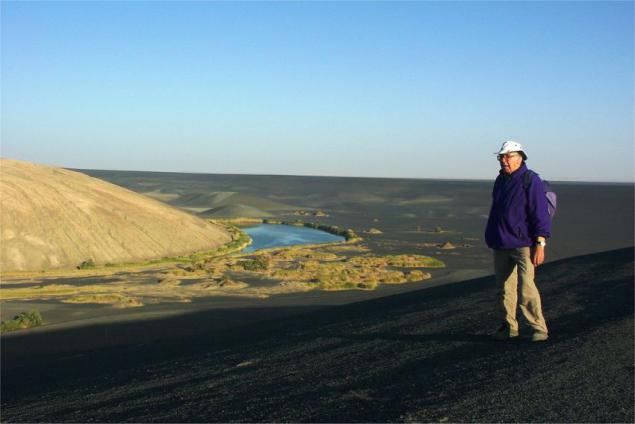
Very much in such trips depends on the conductor. Back in ancient times, they head responsible for the safety and lives of travelers. It would seem that the times have changed. But no! The same is true now, either with their "wards" guides safely back to the oasis, or together with them remain the same in the Sahara forever.
The guides do not just fulfill them paid dengi.Oni discover a new world. They love the desert, and are doing everything to those whom they accompany, also fell in the Sahara. Most conductors - whether Arabs or Tuareg - nomadic children or themselves were nomads. After all, until recently accounted for a significant portion of the Bedouin population of Libya, and the transition to a sedentary lifestyle, they began only after the 1969 revolution. Yes, they like to live in cities, but at heart they are still the people of the desert, and each exit to the Sahara for them - a holiday. You will not believe me, but I saw how they were transformed in preparation for a trip to the Sahara.
I'll tell you about a trip to the mysterious Wau en Namus. Most of its path passes through vast plains covered with giant pebbles, large black stones, which, swaying from side to side, the car slowly creeps forward. It is hard to imagine a more lifeless place.
But the more of these black stones after striking a meeting with the "lost world". Against the background of a bright sky suddenly appears something like the shadow of a cloud. It is blue-black, covered with lava dust slope behind him - break 200 meters depth. Opens with a view of the edge of the slope is difficult to describe in words, of him is literally breathtaking.
Wau en Namus - a crater of an ancient volcano, covering a ten-kilometer oval which lies in its crater valley. In this valley, on the yellow sand there are three bright blue lake fringed belts four-meter cane. Between them scattered several smaller, miniature lakes ultramarine colors, each of which is surrounded by snow-white salt ring. Nearby are two small lakes with water ... red, dazzling sparkling in the sun. On the black edge of the crater is projected green palm trees and tamarisk.
The first impression of this witch landscape: this can not be real. But running a minute and a mirage does not dissipate - lakes are blue and red, the tops of palm trees and tamarisks swaying in the wind, and in the middle of the imposing towers as guardian of basalt, another small volcano. There are no clouds, it does not rain. Surface of the lake reflects the millennia even sunlight.
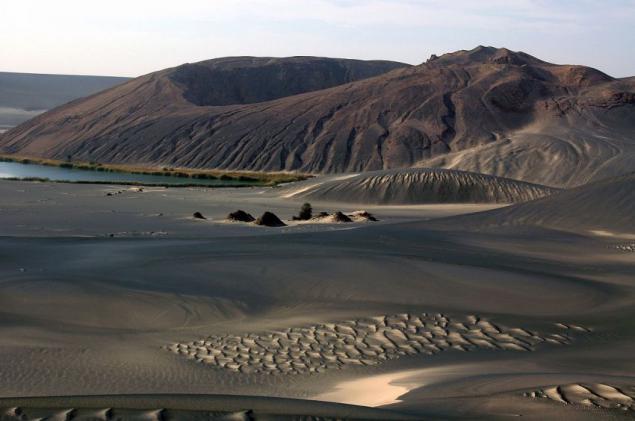
In the evening when the wind dies down and the desert comes complete rest, the surface of the lakes is divided community: someone swims to the surface. Maybe it is - another Loch Ness monster? Anyway, if you like, and lives somewhere, most likely not in Scotland, and the "lost world" of the Libyan Sahara.
There incommunicado live, hunt and breed animals fall in the sand over-ripe figs, but there is no man. Why? Perhaps due to the fact that Wau en Namus is already too "detached"? Or for another reason?
Anyway, for some reason, the conductors are not advised to spend the night at the bottom, strongly suggest raised at the outer edge of the crater. They explain this by saying that in Wau en Namus huge number of mosquitoes ("Namus" just means in Arabic "Mosquito"). When we offer them is still to stay there for the night, given that the tents are equipped with mosquito nets and we fail to drugs, blood-sucking insects repellent, conductors come in clear confusion and, after consulting with each other, they say that it is better that all- did not do that at the bottom is unsafe. "A top - safe?" - "Yes, absolutely." - "Why is dangerous here?". In response to the silence. So we do not manage to find out what the deal here.
At sunset darkness falls instantly. Strewn with big stars cosmic abyss suppresses its grandeur.
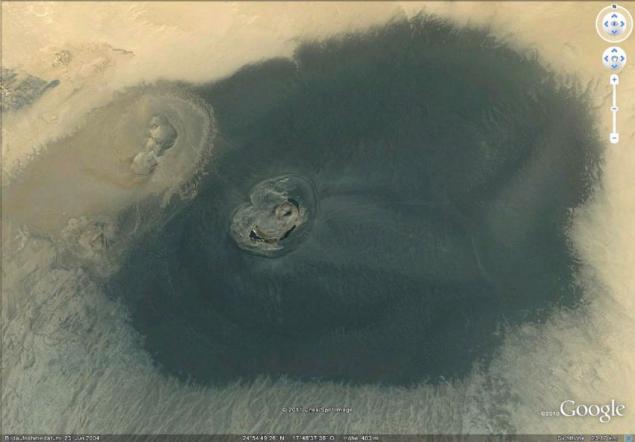
Suddenly our guides jump up and start to peer anxiously into the distance. On the opposite side of the crater there are some reflections. What is it? Mysterious hello once existed and then strewn sands mysterious civilization of Garamantes - Garamandity? Or is it - a UFO? Neither one nor the other. Silence penetrates strained roar of engines: with difficulty overcoming the slope, someone's car slowly climb the hill. We asked the conductor, who could it be. They answer that probably tourists, but confidence in their voices there.
Of course, it can be tourists. But here they are taken very rarely. Army patrol? Maybe. Or lovers of gain? That would be the worst. The attacks on travelers in the Sahara are extremely rare, but there are ...
Lights coming. Going first motorcycle brakes sharply, and he jumps ... a girl of twenty-five. Before us Italians, six people who travel by relying on "Gee Pi-Es" - satellite system orientation. They are going to go down into the crater. We explain to them that to move out in the dark for two hundred meter cliff is almost impossible, but, even if they manage to do it, where they just eat - not wild animals, as "Nessie", it is not there the mosquitoes. Italians decided to heed the warnings and break up their camp next to ours.
With the first rays of the sun travels - Italians to descend into the crater, and we - back to Temesse, leading to Tripoli asphalt. In Moscow whirl Wau en Namus quickly forgotten, disappearing. But sometimes it seems that the real is not Moscow, not snowy slush, not the low sky and slumbering under the dazzling sun "lost world" of the Sahara.
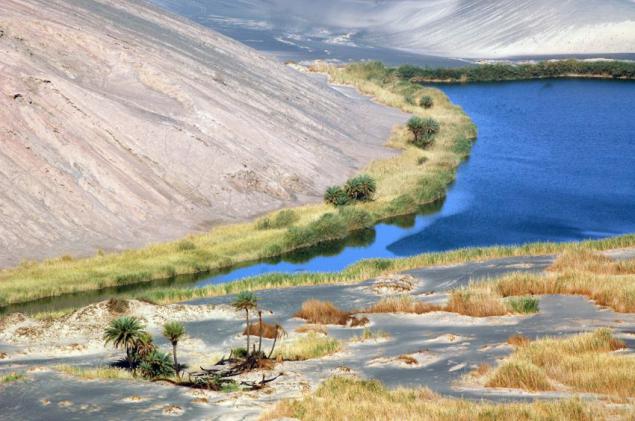



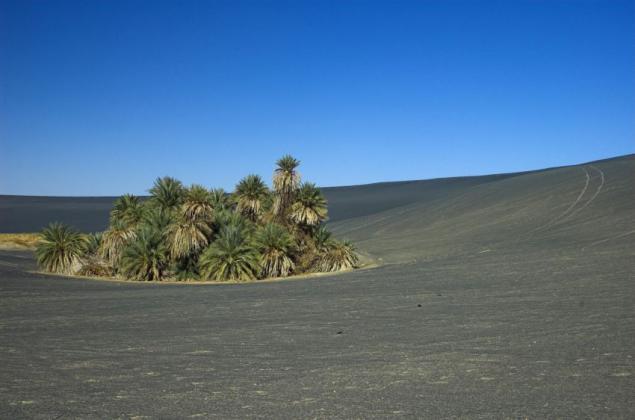

Pre-Islamic burial site in south-west Marideta.
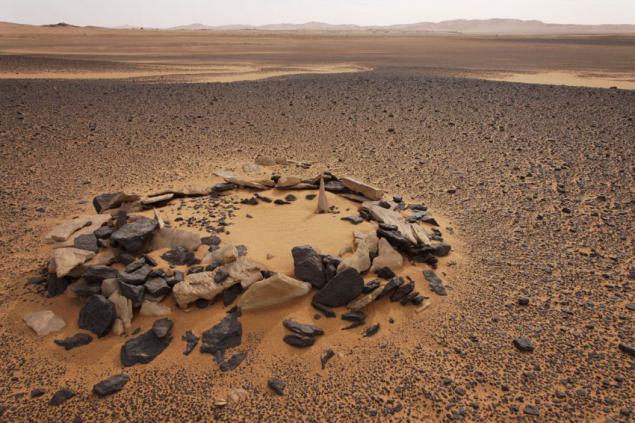
Source: masterok.livejournal.com


The general phenomenon in the Sahara desert - the emergence of drinking water close, or almost the same place where the salt lakes. This water source feeds the lake, and has even been used by travelers in the old days. Due to the presence of fresh water in this remote volcano Wau en Namus, has always been an important point for caravans en route from Waw Al Kabir to the oases and al Kufraha Rebiany in south-eastern Libya.

The size of the caldera Wau en Namus, and the adjacent fields are so large that they can be seen from Earth orbit.

On a picturesque volcano first reported by the outside world, Karl Moritz von Boyrman (1862) and Gerard Rohlfs (1881), although they have never visited this place. Probably the first European who visited the volcano and said about him, was a Frenchman, Laurent Lapierre (1920). Lapierre was an officer who had been captured in battle and escorted through these places. He has an opportunity to tell about his adventures after his release a few years later.

About eleven years later, the Italian geologist Ardito Desio reached Wau en Namus during his famous expedition on camels. In his geological expedition Desio also visited many other places and made a geological description of the volcano for the first time in 1935.

After the Second World War, several scientists visited the volcano, including a geographer Nicholas Benjamin Richter, who made several visits and published a book on his trip to the region in 1960. Since that time, and because the Libyan government began issuing oil concessions in Libya, several geologists, geophysicists and tourists visited Wau-Namus, to explore adjacent areas, or because they were involved in the descriptions of the volcano. Over the past two decades Namus has become one of the main destinations for most tourists who visit the Libyan desert in general, and the Fezzan region in particular.

The area near the caldera is of great interest not only for geologists but also for historians and archaeologists. In the region were found traces of the ancient culture of Nok, including very high-quality items made of iron.
Wau en Namus - a popular tourist attraction, every year it visited by hundreds of guests from all over the world.

Tells traveler Borisov
Nicholas: And today I invited a hammam traveler Borisov, who has several times been in the Sahara. Alex, tell us about your impressions.
Alex: When I remember my trip to the Middle East and North Africa, the first thing comes to mind is the image of the desert. Indeed, most of the territory of the country is desert, including the greatest of them - the Sahara. About her I will tell.
"The Lost World" - not the one on which he wrote Conan Doyle, and existing in reality - is at the heart of the Sahara and is marked on the map of Libya Arabic script, emerging in the name of "Wow en Namus". The path to it, we started a thousand kilometers from the Mediterranean Sea in an oasis Temessa. Here ends the asphalt, hence we had to overcome 300 kilometers of emptiness - emptiness of the absolute, where there are no roads, no people, no animals or even plants. Can you imagine what are as yet unknown to you parts of our planet.
Ivan: And you're not kidding? It is possible today to get into the lost world? And it's so easy?
Alex: Of course not. Venture on such a journey we must prepare for what will have to face the real dangers that await the traveler in the desert. Of course, those times when caravans crossed the Sahara, slowly move from oasis to oasis and leave behind the dead camels and people are gone. Today's travelers are moving jeep, enjoying the coolness of the air conditioners. And yet ...
Anne: Journey to the modern machines, air-conditioned ... No dangerous you say?
Alex: The main danger of such trips - a shortage of gasoline. Too heavy sands lead to a waste of fuel. And if losing orientation, the machine skips past the oasis, gasoline is quickly coming to an end, for it ends with water, and with it the life.
Natasha: Are you talking seriously?
Alex: It is serious. Desert - is unknown. However, before going into the absolute emptiness, tourists are sure to report to the police, and if the tourists do not come back for too long, the power, of course, organize the search. However, lost in the desert to find the car is not easy, believe me. And even if you find the help comes too late. In January 2003, recently died in the Sahara Rider Paris-Dakar rally. No, the desert requires a very serious preparation.

In the Sahara there are no roads. No, and for good cards: even the famous guidebooks "Mishlen" these areas are shown only schematically. Appreciated, however, the map of the Soviet General Staff during the Second World War, will be on sale in Germany after the collapse of the Soviet Union. Once they were top secret, and the name of the Soviet Lawrence of Arabia, Shtirlitsa Sahara, is still unknown, but the fact remains that neither the Germans nor the Allies did not have such cards, which were made by Soviet intelligence. And now to get them because of the small circulation is not so easy.
The second danger - sandstorm. And in Libya is the word "death" is the title of the worst of the wind, which brings death- "death", the accent on the last syllable. Wind raises clouds of sand, travelers are in the swivel haze. Sand penetrate the clothing, leather whips, clogged nose and mouth, preventing breathing. But the worst - the loss of visibility when barely visible hood of his car. This wind can blow for several days, and travelers are doomed. It is the wind destroyed many years ago, the whole Persian army. But that's another story ...
It should be ready for sudden changes in daytime and nighttime temperatures, to the unusual dryness of the air, to the searing glare znoyu and hanging over the head of hot sun, and unexpected encounters with poisonous snakes. And these treacherous quicksand that as a swamp, suck, swallow people?
But the one who dares to leave this world without shadows, the earth will be able to admire the landscape of unearthly beauty, feel and understand the desert, to understand its greatness. At the last oasis of green spot on the horizon disappears everything connected with ordinary, everyday zhiznyu.Vy forget even their own prshlo. The man turns out to be one on one not only with nature, but with Infinity, one on one with the cosmos.

Very much in such trips depends on the conductor. Back in ancient times, they head responsible for the safety and lives of travelers. It would seem that the times have changed. But no! The same is true now, either with their "wards" guides safely back to the oasis, or together with them remain the same in the Sahara forever.
The guides do not just fulfill them paid dengi.Oni discover a new world. They love the desert, and are doing everything to those whom they accompany, also fell in the Sahara. Most conductors - whether Arabs or Tuareg - nomadic children or themselves were nomads. After all, until recently accounted for a significant portion of the Bedouin population of Libya, and the transition to a sedentary lifestyle, they began only after the 1969 revolution. Yes, they like to live in cities, but at heart they are still the people of the desert, and each exit to the Sahara for them - a holiday. You will not believe me, but I saw how they were transformed in preparation for a trip to the Sahara.
I'll tell you about a trip to the mysterious Wau en Namus. Most of its path passes through vast plains covered with giant pebbles, large black stones, which, swaying from side to side, the car slowly creeps forward. It is hard to imagine a more lifeless place.
But the more of these black stones after striking a meeting with the "lost world". Against the background of a bright sky suddenly appears something like the shadow of a cloud. It is blue-black, covered with lava dust slope behind him - break 200 meters depth. Opens with a view of the edge of the slope is difficult to describe in words, of him is literally breathtaking.
Wau en Namus - a crater of an ancient volcano, covering a ten-kilometer oval which lies in its crater valley. In this valley, on the yellow sand there are three bright blue lake fringed belts four-meter cane. Between them scattered several smaller, miniature lakes ultramarine colors, each of which is surrounded by snow-white salt ring. Nearby are two small lakes with water ... red, dazzling sparkling in the sun. On the black edge of the crater is projected green palm trees and tamarisk.
The first impression of this witch landscape: this can not be real. But running a minute and a mirage does not dissipate - lakes are blue and red, the tops of palm trees and tamarisks swaying in the wind, and in the middle of the imposing towers as guardian of basalt, another small volcano. There are no clouds, it does not rain. Surface of the lake reflects the millennia even sunlight.

In the evening when the wind dies down and the desert comes complete rest, the surface of the lakes is divided community: someone swims to the surface. Maybe it is - another Loch Ness monster? Anyway, if you like, and lives somewhere, most likely not in Scotland, and the "lost world" of the Libyan Sahara.
There incommunicado live, hunt and breed animals fall in the sand over-ripe figs, but there is no man. Why? Perhaps due to the fact that Wau en Namus is already too "detached"? Or for another reason?
Anyway, for some reason, the conductors are not advised to spend the night at the bottom, strongly suggest raised at the outer edge of the crater. They explain this by saying that in Wau en Namus huge number of mosquitoes ("Namus" just means in Arabic "Mosquito"). When we offer them is still to stay there for the night, given that the tents are equipped with mosquito nets and we fail to drugs, blood-sucking insects repellent, conductors come in clear confusion and, after consulting with each other, they say that it is better that all- did not do that at the bottom is unsafe. "A top - safe?" - "Yes, absolutely." - "Why is dangerous here?". In response to the silence. So we do not manage to find out what the deal here.
At sunset darkness falls instantly. Strewn with big stars cosmic abyss suppresses its grandeur.

Suddenly our guides jump up and start to peer anxiously into the distance. On the opposite side of the crater there are some reflections. What is it? Mysterious hello once existed and then strewn sands mysterious civilization of Garamantes - Garamandity? Or is it - a UFO? Neither one nor the other. Silence penetrates strained roar of engines: with difficulty overcoming the slope, someone's car slowly climb the hill. We asked the conductor, who could it be. They answer that probably tourists, but confidence in their voices there.
Of course, it can be tourists. But here they are taken very rarely. Army patrol? Maybe. Or lovers of gain? That would be the worst. The attacks on travelers in the Sahara are extremely rare, but there are ...
Lights coming. Going first motorcycle brakes sharply, and he jumps ... a girl of twenty-five. Before us Italians, six people who travel by relying on "Gee Pi-Es" - satellite system orientation. They are going to go down into the crater. We explain to them that to move out in the dark for two hundred meter cliff is almost impossible, but, even if they manage to do it, where they just eat - not wild animals, as "Nessie", it is not there the mosquitoes. Italians decided to heed the warnings and break up their camp next to ours.
With the first rays of the sun travels - Italians to descend into the crater, and we - back to Temesse, leading to Tripoli asphalt. In Moscow whirl Wau en Namus quickly forgotten, disappearing. But sometimes it seems that the real is not Moscow, not snowy slush, not the low sky and slumbering under the dazzling sun "lost world" of the Sahara.






Pre-Islamic burial site in south-west Marideta.

Source: masterok.livejournal.com


